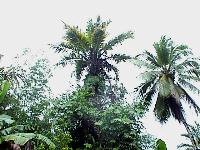
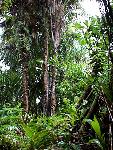
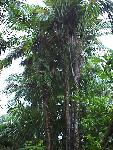
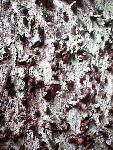
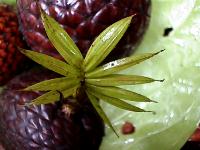
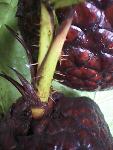
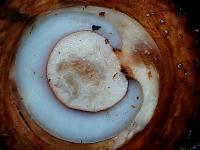
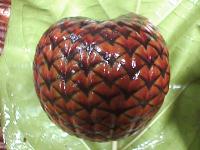
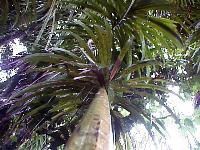










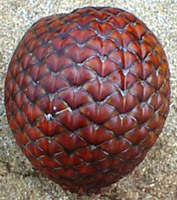
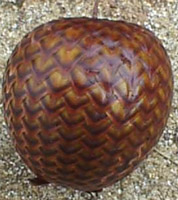
Scientific classification Kingdom: Plantae (unranked): Angiosperms (unranked): Monocots (unranked): Commelinids Order: Arecales Family: Arecaceae Genus: Metroxylon Species: M. amicarum Binomial name Metroxylon amicarum (Wendl.) Becc.
Original 1998 photographs taken in the Nanmand area, 27 November1998 by Jenson Santos. Additional photos taken in 2000 by Dana Lee Ling in Nantipw, Lewetik, at time when Pelsihner Elias added ethnobotanical information to this page.
Habit: Terrestrial; usually found in wet, swampy areas and river sides. Found only on Pohnpei and Chuuk.
Leaf shape and morphology: Leaves are large (25-30 ft) in length. Divided once; leaflets are linear and parallel veined (3-4 ft. long), even pinnately compound. Leaflets pointing posterior arranged dorsally, unlike coconut palm that has its leaves arranged laterally. Entire but sharp leave margins.
Stem type: Woody (lignified) stem often grows to heights 80 feet (25 m) or more. Prickly, large stem 3-5 ft. in diameter. Young ones are pubescent.
Floral characteristics: Flowers on large inflorescence branches located axillary. Flowers are produced regularly which enables it to constantly bear fruits.
Fruit: Round (4-6 in., 10-15 cm) in diameter. Fruit skin (exocarp) is scalelike. Fibrous mesocarp; white meat (endosperm) covering embryo. Embryo is soft when young and hardens when old.
Uses: Ivory leaves are a main source of roof thatch on Pohnpei. The fruit (white meat) is eaten by pigs and shrimps. Young leaves and stem cork (phellem) are important sources of local medicine.
Pelsiher Elias
The Oahs plant is also considered the most important plant here in Pohnpei. It is an indigenous plant for it has been here for thousands of years. On the other hand, according to the legend there's a story about how Oahs plant came to and its importances. According to the legend ,way back in the early centuries when Pohnpei was built there weren't any tree on Pohnpei. People live in houses of rocks with no roofs. By then there was a lady who came from somewhere and found out that these people live under rocks with no roofs so she went back to her place and sent an Oahs plant by some form of magic. So those people of that time used the leave for roof and the rest of the plant for some other significance uses.
Nowadays we still consider Oahs as an important plant for all its important uses. Among all the plants I know Oahs is use for so many things and if we loss this plant someday we would have die. All the parts of the plant has their own special uses like the roots, the stem the fruits,seeds, the flowers and even the leaves.
The roots are use for medicine. For example when a person got injured the roots of the Oahs is the best thing for treatment. The stem of this plant is use for floorboards of local huts and also for support of the huts roof. The fruits but especially the white part is use for feeding pigs and shrimp. The small flowers which turn into the fruits is the food for the birds. The leaves are use for local medicine also and thatch roof. The floral bracts of this plant is use for carrying sakau, use for making toy.
Another signifigant of this plant is birds like to make their nest on top part of the plant. So to sum up the uses of the plant include treating sicknesses, for house roofs and floors and carrying other heavy things like sakau.